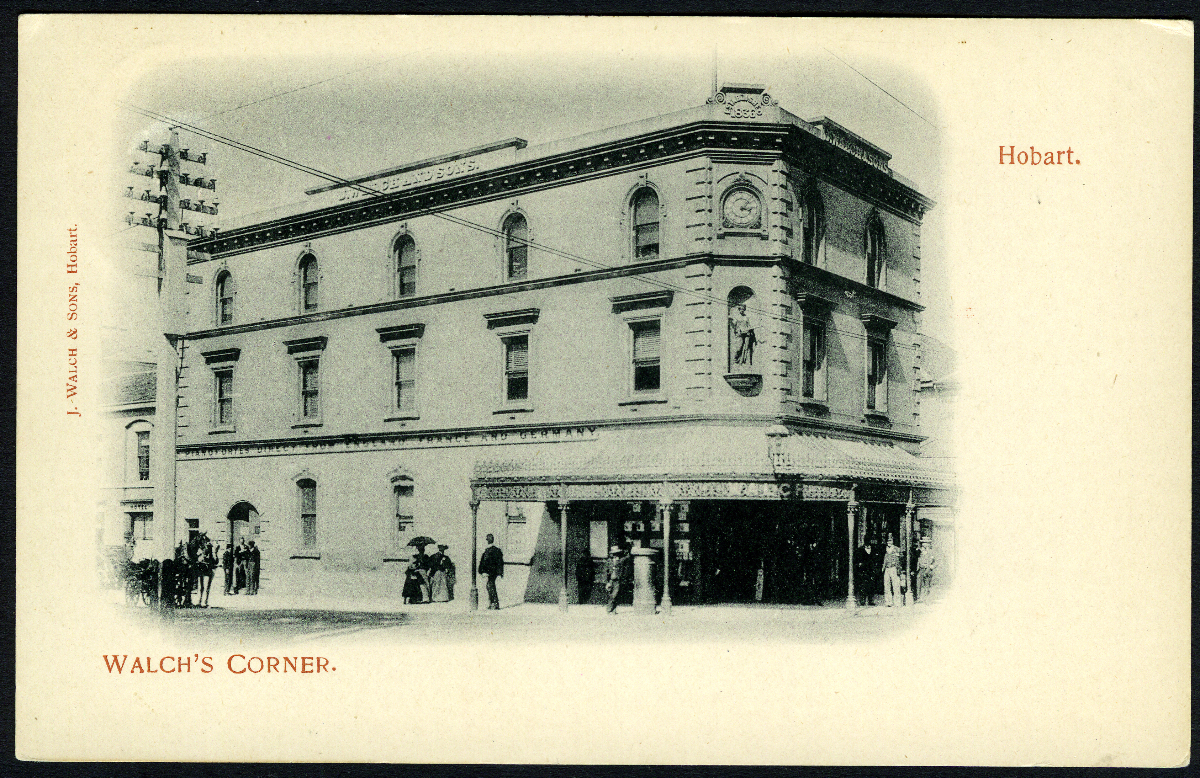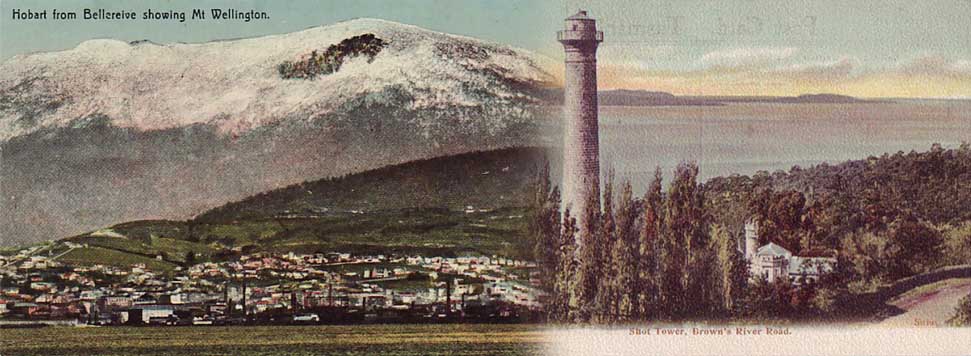J. Walch & Sons 1905-13 B&W
Select card series to view
About the publisher
The firm of J. Walch & Son was established in 1846, when Major J.W.H. Walch (1788-1852) purchased the bookselling business of S.A. Tegg, at Wellington Bridge, on the corner of Elizabeth and Liverpool Streets (so named because the Hobart Rivulet crosses Elizabeth Street at this point). Major Walch, who had served with the 54th Regiment in India, had spent several years back in England before moving his family of wife and seven children to Tasmania in 1842. He had been granted land in the Westbury District, but sold it in favour of business in Hobart. He took his eldest child James (James Henry Brett Walch, 1825-1897) into the business with him, opening on 1 January 1846 as J. Walch & Son.
Major Walch died in 1852. In 1853 his second son Charles (Charles Edward Walch, 1830-1915) became a partner in the business, and the name was changed to J. Walch & Sons.
In 1861 an account book manufactory and stationery store was built in Macquarie Street, and James Walch took over its management; he continued this until his death in 1897. In 1873, the premises in Davey Street that backed onto the Macquarie Street site were purchased and fitted out as a wholesale paper and stationery warehouse. In 1876, the original Wellington Bridge building was demolished and replaced by a three storey building, which became known as Walch's corner, presenting a statue and the face of a town clock to the intersection. (The illustration below is from a Walch postcard published in 1901). In 1891 the Macquarie Street store was further enlarged. Charles Walch managed the Wellington Bridge store from 1861 until his death in 1915. The Wellington Bridge building was sold in 1921.
The company remained in family hands, managed by successive family members, and continued to prosper through most of the 20th century, but by 1990 it could not compete with large national enterprises. It had not continued to expanded, operating only from its single property in Macquarie Street. The printing department was merged with Mercury Press to form Mercury-Walch in 1969. The stationery business was sold and the remainder went into voluntary liquidation in 2003.
In 1863 the firm purchased a bookselling business in Launceston, operating first in their own name and later as Walch Bros. & Birchall. When Birchall died in 1893 his sons bought the business which then operated as A.W. Birchall & Sons. They imported goods, including postcards, through Walch’s London agent, and also published some under their own name.
In 1900 a new printing department and manufacturing facility was added to the Macquarie /Davey Street complex. In Walch’s Literary Intelligence of July 1900, they said “The addition to our manufacturing plant is now an accomplished fact, and we are Printers as well as Bookbinders and account book manufacturers”. This facility allowed Walch’s to print their own postcards, which they started doing with their 1903 Series.

J. Walch & Sons were responsible for two important serial publications. Walch’s Tasmania Almanac, informally known as the Red Book, was the standard reference to Tasmanian business and affairs, being published annually for 107 years, the period 1863-1970. Walch’s Literary Intelligencer, published over the period 1859-1916, was a 16 page monthly advertising and literary news booklet that now provides a wealth of historical detail of the products sold by the firm, including the postcards of the period 1900-1915.
Walch’s retained an agent in London to manage their affairs there. Walch’s in Hobart wrote a letter to London weekly, but it took five weeks (in 1906) for the letter to reach London. On receipt of the Hobart letter the London agent sourced the requested goods, negotiated pricing, placed orders, arranged payment, took delivery and organised shipping. In reply, the agent wrote a weekly letter back to Hobart reporting on progress, advising of availability, quality, pricing and shipping arrangements and dispatched invoices and receipts. Again it took five weeks for the letter to reach Hobart. When the transcontinental and undersea cable connected Australia to England, orders for urgent items were sometimes sent by telegram, but the rate of a shilling per word made its use prohibitive for most purposes. However, around 1906, postcards were selling so well that telegrams using a system of agreed codewords, were used to order new supplies. For example, telegramming the single word ‘Peculiar’ meant ‘Send £10 worth coloured actress cards of Philco brand’.
The firm imported a range of goods in addition to stationery. In the period 1900-1910, these included:
- Books: Novels, history, geography, religious, school texts
- British magazines, such as Word-Wide Magazine
- Maps, such as Large Print Map of South Africa
- Text books, music scores, military and scouting books
- Japanese goods – tea sets, lacquered trays, chinese lanterns
- Printed pictures, enlarged photographs, photo frames
- British newspapers, such as Illustrated London News
- Pianos, in quantity – sometimes ordered 10 at a time
- Golf clubs, cricket goods, lawn tennis racquets, binoculars, ping-pong tables and racquets
- Apple wrapping paper, by the ton
The Walch Post cards
Walch’s published postcards from 1900 to 1915. Up to 1903 their cards were printed in England, but their 1903 series was apparently printed on their own press, as the cards carry the imprint “J. Walch & Sons printers”. From 1906 to 1914 their coloured cards were printed by C.G. Röder of Leipzig, Germany. Over the same period they also printed black & white cards, probably on their own press, but there is no information on the source of the printing plates. Their last cards were printed in colour in England in 1915.
As well as publishing their own cards, Walch’s imported large quantities of British made cards. The correspondence with their London agent, particularly over the years 1905-1907, provides a detailed record of what was requested and sent, the state of the market in Hobart at the height of the postcard boom, and an insight into Walch’s taste in postcards.
The table below is a summary of the series of cards published by J.Walch & Sons.
|
Date Published
|
Series
|
|
1900
|
Walch 1900 Series
|
|
1901
|
Walch 1901 Series
|
|
1902
|
Walch 1902 Series
|
|
1903
|
Walch 1903 Series
|
|
1904
|
Walch 1904 Series
|
|
1904
|
Walch 1904 Coloured Series
|
|
1904
|
1904 Wide Series 1
|
|
1904
|
1904 Wide Series 2
|
| 1903 or 1904 | Undivided Unknown Series |
|
|
|
|
Coloured Series:
|
|
| 1905 | Series A-20,000 |
| 1905 | Series B-24000 |
| 1905 | Series F-1905 |
|
December 1905
|
Series G-1906
|
|
December 1906
|
Series G
|
|
1907
|
Series 119,000
|
|
1907
|
Series 120,000
|
|
Second half of 1908
|
Tasman Series 1908
|
| Mid 1909 | Tasman Series 1909 |
| Early 1910 | Series 207,000 |
| Late 1913 | Tasman Series 1913 |
| Late 1915 | Tasman Series 1915 |
| B&W Series: | |
| Early 1905 | Series C-24,000 |
| Mid 1905 | Series C-1905 |
| 1905-1907 | Series C |
| 1905 | Series D-1905 |
| 1905 or 1906 | Series D |
| 1905 | Series E-1905 |
| 1906 | Series E |
| 1906 | Series H-1906 |
| 1906 or 1907 | Series H |
| 1907 | Series J |
| 1910 | Rotary Photo 1910 Series |
| 1913 | Rotary Photo 1913 Series |
| 1906-1907 | Specials |
Bibliography
Anon. (n.d.) The Man & Other Families. Walch Family. http://www.manfamily.org/about/other-families/walch-family/ Accessed 13 September 2009.
Anon. (1900) The Cyclopedia of Tasmania (illustrated) : an historical and commercial review : descriptive and biographical, facts, figures and illustrations : an epitome of progress : business men and commercial interests. Hobart:Maitland and Krone, Publishers.
Archives Office of Tasmania. Series NS2857. Letters from London [to Hobart]
Death of Mr. James Walch. The Mercury Hobart 6 November 1897.
J. Walch & Sons. (1942) The Walch Family Centenary. Hobart: J. Walch & Sons.
J. Walch & Sons. (1946) Centenary Picnic 16 March 1946. Hobart: J. Walch & Sons.
Walch, John. (2006) J. Walch and Sons in The Companion to Tasmanian History http://www.utas.edu.au/library/companion_to_tasmanian_history/W/Walch.htm. Accessed 16 February 2013.
